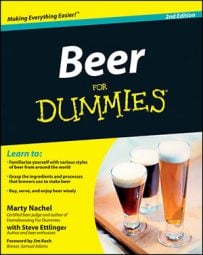Of the 400 or so breweries that reopened following Prohibition, about half never regained the financial ground that had been lost; they eventually shut their doors. Even as new breweries continued to open, most found that the market had changed considerably. Several factors came into play: the introduction of the beer can, World War II, improved shipping methods, television, industry mergers and buyouts, and consumer preferences.
The impact of the beer can
The introduction of the beer can to the consumer market in 1935 helped change the way Americans drank their beer — or at least where they drank their beer. Previously, most of the beer consumed in the United States was drunk in draught form, usually at a neighborhood tavern or saloon or carried home in a bucket. It was always fresh. With the convenience of the beer can, Americans began to buy it in stores and in bulk and to drink it at home. Breweries that couldn’t afford the expensive equipment necessary to can their beer lost a piece of the pie.
The effects of World War II on the beer industry
World War II had a major impact on the brewing industry for a number of reasons. For starters, a huge chunk of the beer-drinking demographic was off to war. Replacing the young men down at the munitions plant were young women, many of whom didn’t drink beer or only drank the lightest stuff available — which was just as well, as a general conservation effort was going on and brewing ingredients were in short supply.
The men stationed at U.S. military bases were all drinking the only beer available down at the PX, one that was contract-brewed for the government. Ironically, while stateside military personnel were all forced to drink the government-issue beer, troops stationed in Europe brought home a taste for western European brews.
Improved shipping methods for beer
Immediately following World War II, and for many years beyond, over-the-road and rail transportation systems were greatly improved. In addition to greater access and higher speeds, refrigerated trucks and rail cars were a boon to the industry. Big breweries could ship their beer much farther, much faster, with limited adverse effect on the beer. The new interstate highway system introduced in the 1950s only made things better for the big guys.
The impact of television on beer
Television, believed to be a vast wasteland when it was first introduced, is at least partly to blame for creating a wasteland in the American brewing industry. TV proved to be an invaluable medium for large, high-resource breweries looking to capture a greater share of the marketing pie. In raising advertising competition to a new level, TV helped create the concept of national-brand beers and galvanize the concept of beer product recognition and brand loyalty.
Brewery mergers and acquisitions
Following the four-hit combination of beer cans, World War II, better shipping methods, and TV, all landed over a 20-year period, many welterweight breweries were either KO’d or were hanging on the ropes and given a standing 8-count. This is when the heavyweights took off the gloves for the finishing blow. Most of the remaining small breweries in the 1960s and 1970s were beaten to a pulp by the brewing titans and became pawns in a high-stake game of mergers and acquisitions. Brewing plants were shut down, and brand names and labels became movable property.
Consumer beer preferences
Not long after the beer wars of the 1960s and 1970s, the United States was swept into a health and fitness craze. Beer never did rank high on any fitness buff’s list of desired foods, so it had to gain acceptance or fall by the wayside. Along came light beer.
By around 1980, beer drinkers were left with a half-dozen major brewing companies and a couple dozen regionals, producing millions of barrels of very light, very stable, very consistent beer. Interestingly, this style of beer making became a double-edged sword for the industry.
Despite megabrewed beer’s popularity, beer drinkers began to complain that this level of lightness, stability, and consistency had turned much of the world’s beer into a very dull and lifeless product. This pallid mediocrity in the beer marketplace eventually led to the demand for tastier beer.

